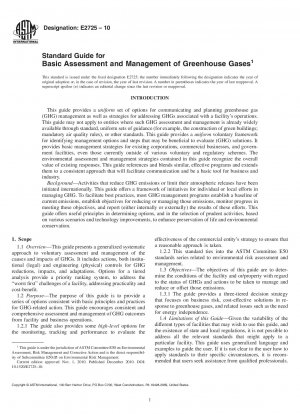ASTM E2725-10
Standard Guide for Basic Assessment and Management of Greenhouse Gases
- Standard No.
- ASTM E2725-10
- Release Date
- 2010
- Published By
- American Society for Testing and Materials (ASTM)
- Status
- Replace By
- ASTM E2725-19
- Latest
- ASTM E2725-19
- Scope
The use of this guide would be directed toward prudent business decision making, communications regarding GHGs emissions/control/reduction conditions, insurance, high-level analysis of potential reductions and/or remedies, budgeting, strategic planning for an entity’s management of GHGs produced in relationship to its business.
Example Users:
Small businesses or enterprises;
Service industries;
Federal, state or municipal facilities and regulators, including departments of health and fire departments;
Financial and insurance institutions;
Waste managers, including liquid and solid waste haulers, treatment, recycling, disposal and transfer;
Consultants, auditors, inspectors and compliance assistance personnel;
Educational facilities;
Property, buildings and grounds management, including landscaping;
Non-regulatory government agencies, such as the military.
This guide is a first step in crafting simplified management goals for assessing, managing and reducing GHGs. The framework describes a process by which the user may categorize current carbon footprints and a priority approach to manage those risks. The technique classifies common responses for both mitigation and adaptation. The guide groups responses and examples into tiers based on the relative speed in responding to GHG emissions. The tier classifications found in this guide reflect the general structures of state, federal, and local response programs. These authorities generally classify groups of similar responses according to the timely availability and cost effectiveness of GHG responses.
This guide presents basic principles and strategies in the U.S. for conducting baseline assessment and reasonable mitigation/adaptation strategic options on a corporate, or small business voluntary basis. The following principals apply to this priority system:
Ability to set specific GHG goals for activities. These goals may include maintaining existing outputs of GHG while increasing a facility’s operations, or reducing GHG through engineering changes while maintaining current operations.
Marketing environmental awareness and sensitivity;
Assessing risks from future GHG events;
Risk management, underwriting; loss control and history; premiums and claims;
Liability assessment and qualifications for loans;
Standardization, consistency, and certification of facility specific evaluations;
Educating employees, clients, and customers;
Generating multi media and cross medium information;
Evaluating vendors, and
Reducing costs and preventing pollution.
Users may consider various benefits of GHG assessment and response.
This guide is a basic primer on GHG impacts and may serve to introduce the subject for organizations unfamiliar with the principles.
Some government enforcement agencies, fiduciaries and business organizations publish GHG strategies. Over 400 municipalities in the United States, for example, have signed the principles of international standards to address GHGs. The public has systematic ability to access or estimate information on individual businesses. Therefore, businesses need guidance on how to assess the nature and potential risks of GHGs, and a programmatic approach for reducing or eliminating those risks through energy conservation, pollution prevention, alternative and emerging technologies and other proactive management systems.
Note 38212;Users may wish to consider establishing data quality objectives, data management procedures, and documentation.
Reduced operation and maintenance costs may be realized th.........
ASTM E2725-10 Referenced Document
- ASTM E2114 Standard Terminology for Sustainability
- ASTM E2432 Standard Guide for General Principles of Sustainability Relative to the Built Environment
- ISO 14001 Environmental management systems - Requirements with guidance for use [Spanish version]
- ISO 14065 General principles and requirements for bodies validating and verifying environmental information
ASTM E2725-10 history
- 2019 ASTM E2725-19 Standard Guide for Basic Assessment and Management of Greenhouse Gases
- 2010 ASTM E2725-10 Standard Guide for Basic Assessment and Management of Greenhouse Gases
